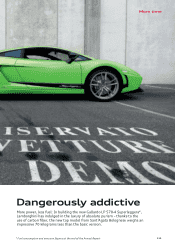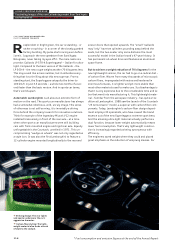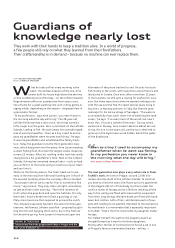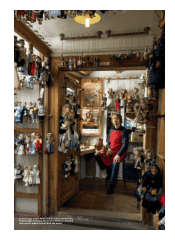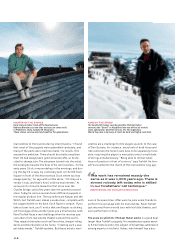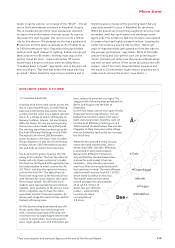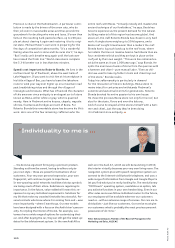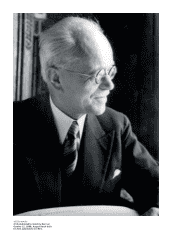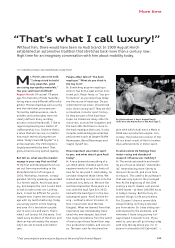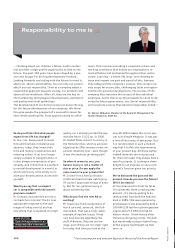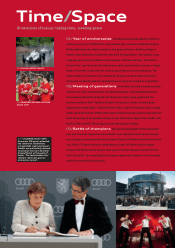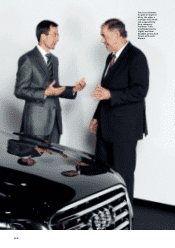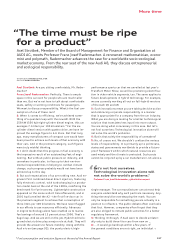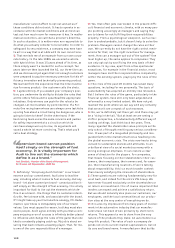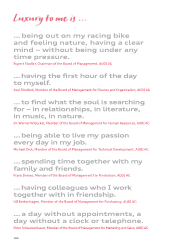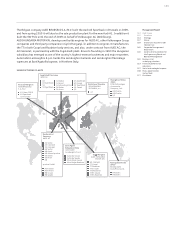Audi 2009 Annual Report Download - page 126
Download and view the complete annual report
Please find page 126 of the 2009 Audi annual report below. You can navigate through the pages in the report by either clicking on the pages listed below, or by using the keyword search tool below to find specific information within the annual report.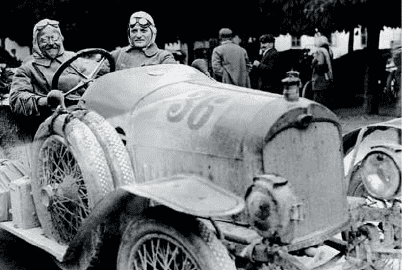
More time
123
r. Horch, you once said:
“I always tried to build
only powerful, good
cars using top-quality materials.”
Has your wish been fulfilled?
August Horch: Of course! 70 years
ago, the business of body manufac-
turing was a very different affair alto-
gether. Precise drawings were a rarity
and the individual processes per-
formed by leatherworkers, coach-
builders and cartwrights were not
clearly defined. Every working
process involved handicraft. I like to
regard engineering as a matter of
craftsmanship, too. I believe that is
a value that will survive, no matter
how much technical progress we
make. Today’s Audi R8 Spyder* is a
prime example. The V10 engine is
largely assembled by hand. That
gives a brand a very special quality.
But tell us, what was the maiden
voyage in your very first car like?
H: My first self-developed Horch car
set out from my workshop in the
Ehrenfeld district of Cologne in
1901. Workshop, however, is exag-
gerated. Strictly speaking, we worked
in a former stable. And it was Janu-
ary, but despite the cold I could hard-
ly wait to take a test run. Looking
back, it must be difficult for you to
imagine how I spent the maiden voy-
age with my teeth chattering. Today
you simply switch on the heating,
and even if it’s ten below outside
you’re soon nice and warm. That’s
what I call luxury! All the same, I rel-
ished every moment of the drive, and
that car was ultimately the reason
why I set out to build even better
cars.
People often talk of “the Audi
mystique.” What do you think is
the key to it?
H: Something acquires mystique
when it has both a past and an emo-
tional pull. Major feats, or “top per-
formances” as you would say today,
are the source of mystique. Do you
remember those silver, streamlined
Auto Union racing cars? They are still
a milestone in motor sport history.
So they are part of the Audi mys-
tique. As indeed are many other fa-
mous cars, such as the Urquattro and
the Audi 100. But there is more to
the Audi mystique than cars. It also
includes outstanding personalities
and pioneers such as Jørgen Skafte
Rasmussen, Bernd Rosemeyer and
maybe myself too.
How important was motor sport
to you, and what does it give Audi
today?
H: A race demands everything of a
car. With rather childlike spirit, the
engineer wants to test the limits of
how far he can push it. And ideally, he
can take it beyond those limits. We
started sending our cars out onto the
racetrack very early on. We won the
Austrian Alpine Run three years in a
row: with the Audi Type B in 1912,
and with the Audi Type C in the two
subsequent years. And I did the dri-
ving – without a driver’s license. In
fact, I never even took the test
(laughs). What we learned from that
experience was immediately trans-
lated into new designs. Just think
how many innovations from the world
of motor sport have found their way
into production models, and vice ver-
sa. The basic unit for the diesel en-
gine with which Audi won Le Mans in
2006 was a production engine. Con-
versely, the production version of the
R8 is a direct result of Audi’s tremen-
dous achievements in motor sport.
To what extent do findings from
motor racing and decades of
research influence our mobility?
H: The words automobile and mobil-
ity are of course related. “Automobil-
ity” means having more liberty to
discover the world, and more time
to enjoy it. This used to be a pleasure
that was only open to the privileged
few. At the beginning of the 20th
century a Horch chassis cost around
9,400 marks – at least 100,000 euros
in today’s money. But the truly im-
portant things in life are priceless.
For 15 years I drove a convertible
whose folding roof only protected
you from above. So I was sitting out-
side exposed to the elements, and
whenever I had a long journey I al-
ways hoped it wouldn’t rain. If you
want to, you can still go driving today
with only the sky above you, for in-
stance in a beautiful A5 Cabriolet*.
“That’s what I call luxury!”
Without him, there would have been no Audi brand: In 1909 August Horch
established an automotive tradition that stretches back more than a century now.
High time for an imaginary conversation with him about mobility today.
M
COPY/ANDREAS FINGAS/INA HÄMMERLING/ELISE PHAM
An Alpine winner is born: August Horch
(left) wins the Alpine Run in the Audi Type C.
* Fuel consumption and emission figures at the end of the Annual Report


